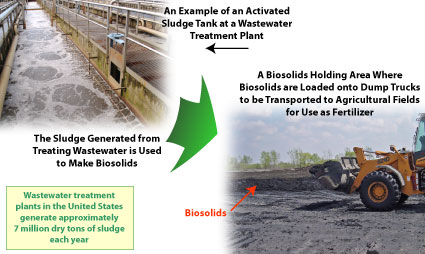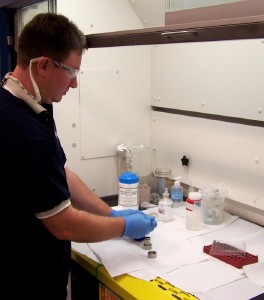Household Chemicals and Drugs Found in Biosolids from Wastewater Treatment Plants
 Biosolids are the sludge generated by the treatment of sewage at wastewater treatment plants (WWTPs). WWTPs produce a variety of biosolids products for agricultural, landscape, and home use. Depicted in the diagram is an activated sludge tank at a wastewater treatment plant (upper left) and a holding area for biosolids (lower right).
Biosolids are the sludge generated by the treatment of sewage at wastewater treatment plants (WWTPs). WWTPs produce a variety of biosolids products for agricultural, landscape, and home use. Depicted in the diagram is an activated sludge tank at a wastewater treatment plant (upper left) and a holding area for biosolids (lower right).
(The two photos are not from the same facility.)
(Click on photo for larger version) |
|
Biosolids, the treated sludge generated by the treatment of sewage at wastewater treatment plants, is something that most people don't think about as they flush everyday chemicals and drugs down the drain. However, U.S. Geological Survey (USGS) scientists found that biosolids contain relatively high concentrations (hundreds of milligrams per kilogram) of the active ingredients commonly found in a variety of household products and drugs.
Wastewater treatment plants (WWTPs) in the United States generate approximately
7 million dry tons of biosolids each year. Since biosolids are rich in plant nutrients, farmers, landscapers, and homeowners use about 50 percent of the annual production of biosolids as fertilizer for plants. Biosolids must meet standards for nutrient, metal, and pathogen content before it can be used to fertilize plants and to improve the quality of soil. Because a variety of pharmaceuticals and other household chemicals have been found in the wastewater discharged from WWTPs, questions have been raised about the presence of these chemicals in biosolids. To help answer the questions the scientists purchased or obtained nine different commercially or publicly available biosolids and analyzed them for 87 organic chemicals found in cleaners, personal care products, pharmaceuticals, and other products. They found:
- Fifty-five of the 87 organic chemicals measured were detected in at least one of the nine biosolids collected, with as many as 45 chemicals found in a single sample.
- Twenty-five of the chemicals were present in every biosolid sample including compounds that are pharmaceutically and hormonally active, such as an antimicrobial disinfectant (triclosan), a musk fragrance (tonalide), an antihistamine (diphenhydramine), and an antiepileptic drug (carbamazepine).
-
 A scientist (now with Colorado State University-Pueblo) preparing samples of biosolids for extraction using accelerated solvent extraction. The samples were analyzed for a broad suite of emerging contaminants.
A scientist (now with Colorado State University-Pueblo) preparing samples of biosolids for extraction using accelerated solvent extraction. The samples were analyzed for a broad suite of emerging contaminants.
(Click on photo for larger version) |
|
Total summed concentrations ranged from 64 to 1,811 milligrams per kilogram (mg/kg or parts-per-million), with many individual contaminants in the hundreds of mg/kg range.
- The biosolids were more similar than they were different, even though they were produced by a variety of treatment processes from plants serving vastly different sized cities and towns. The types of contaminants and their relation to each other did not vary greatly between the biosolids tested.
This is the first comprehensive examination of biosolids, and the results indicate that biosolids have high concentrations of these emerging contaminants compared to treated liquid wastewater effluent. What is not known at present is the transport, fate, and potential ecological effects of these contaminants once biosolids are applied to agricultural fields, garden plots, and landscaped plants and shrubs.
Reference
Kinney, C.A., Furlong, E.T., Zaugg, S.D., Burkhardt, M.R., Werner, S.L., Cahill, J.D., and Jorgensen, G.R., 2006, Survey of organic wastewater contaminants in biosolids destined for land application: Environmental Science and Technology, v. 40, no. 23, p. 7207-7215, doi:10.1021/es0603406.
More Information
Related Headlines
Back to Headlines page
|

|